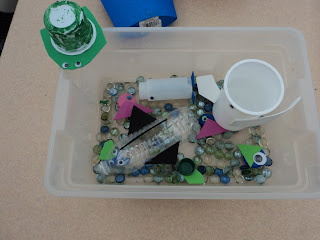Today is my first official day of summer break! I began reading a new "for fun" novel, went for a walk and did a little shopping. :)
You can find Part 1 and Part 2 to see how we got to this place.
Here are the final projects that my students created in our Project Based Learning over the last 2 weeks of school. Each group presented their information and their habitats with the class.
The Cave: moss (Dollar Tree), painted a box black. Bats and Bears Bats were hung from top of box. A hole punch was used to punch 2 holes in each bat. A pipe cleaner was put through then attached to the top of the box with a thumbtack.
The Meadow: Made from a paper box lid filled with shredded paper Easter grass. Butterflies and flowers (Dollar Tree), Milk jug lid insects.
The Ocean: The kids did most of this own their own! Rocks (Dollar Tree); this group was very 'green' in using many of the items we had from our previous recycling unit. The white container is a seal, opaque is a dolphin, green painted juice container is a turtle, and the clear water bottle is a shark. The shark has tiny teeth super glued in the opening. Fish were found here.
The Farm: The barn is made from a box covered in red paper. The silo is an oatmeal container (left over from the recycling unit) that students covered with red paper. All the farm animal idea came from Crafts by Amanda. I showed them a variety of examples of farm animals, but they decided they wanted to make all of them from cardboard tubes. They definitely put their own spin on some of them, but they were really cute! The "hay" is yellow shredded paper Easter grass.
The Rainforest: They used paper bags to create the trees. We cut the bottom of the bags open to give them something to glue to the box. Leaves, tissue paper, lizards and snakes (Dollar Tree). Earlier in the year we made tissue paper flowers. On their shopping list, they asked for tissue paper to make flowers (they had a very detailed shopping list for me), so I thought they were going to make those. They decided to just cut flowers out and glue them to the box. The blue ball in the lower right of the box is a blue tarantula. It is a styrofoam ball wrapped in yarn with blue pipe cleaners attached for legs. What you can't see is that they painted mud puddles in the bottom of the box because "it rains a lot". Some of the snakes and lizards are hung from the corrugated part of the box. This group thought outside the box throughout the project and did not ask for help throughout other than a suggestion on how to make trees (which we googled!).
The Pond: Rocks & snakes (Dollar Tree), Fish and turtle (see ocean above) I think some of the fish with the long "tails" look like tadpoles. :) Frogs are from my math manipulatives. The alligator is the long green stick. If you look closely, you can see his left eye about 1/3 of the way down the stick. He had an eye on each side. They had a great time making him!
Each group also created a "science fair board" where they displayed their information. Below is one example of a complete project with habitat and board. Students presented their projects by sharing the information on the board.
All in all, these projects took about 10 hours to complete, beginning with the research through building the habitat. After presenting to members of our class, another class came to visit and went through the room like a gallery walk, visiting each habitat and asking questions. The following day was Kindergarten Graduation, so families visited the displays in the gallery walk format as well. It was an awesome learning experience for students and myself; they were so proud of their work and excited to share their learning with others!








Nice projects, and great finished products on your science fair boards! Was it a lot of work for you outside of school hours?
ReplyDeleteThanks for sharing,
Heidi Butkus
www.heidisongs.com
http://heidisongs.blogspot.com
Thanks for stopping by, Heidi! It was not too much outside work; the most time consuming part was finding books that students could use to do their research. We used National Geographic Kids website in addition to books and magazines (Ranger Rick Jr., National Geographic Little Kids and Zootles).
DeleteAmanda